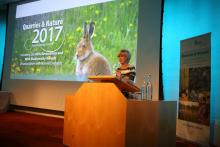Tarmac is carrying out a phased programme to restore 30 hectares at a quarry in the north of England
Scorton Quarry in County North Yorkshire, England, is a busy and complex operational site. It extracts, processes and sells approximately 450,000tonnes of sand and gravel each year, and in 2008 owners
Tarmac also delivers an ongoing community consultation programme, which has resulted in marked improvements being made to the public rights of way.
The quarry is divided into six ‘phases’, and as each phase is worked out, restoration and landscaping of the area follows. Tarmac is halfway through the programme, which is set to be completed by 2016.
Alan Coe, zone manager for North Yorkshire, explained Tarmac’s holistic approach: “Every site is different, and, being the custodian of the land, it is our responsibility to manage it in the best way possible. It was also a fantastic challenge to develop a bespoke restoration programme. From the initial concept plan, we have developed and enhanced the landscape and wildlife habitat at Scorton, while ensuring valuable ecological opportunities are not missed.”
Apart from being an active quarry, Scorton supports a wealth of wildlife and is used and enjoyed by local people, and has an increasing number of visitors annually. Tarmac’s strategy was to ensure that this was maintained and enhanced through its restoration work.
In recent years, the company has created three hecatres of reed beds to provide a new habitat for hundreds of species and has overseen the timely and technical process of growing new reeds from seed, collected locally before being propagated and grown on by local specialist Mires Beck Nursery.
As the reed beds have developed there have been records of a wide range of species such as kingfishers, reed bunting and wild fowl.
During the planning of phase four, ecological studies showed that the location of a mature hedge was favourable for the development of bat colonies. It was decided to move the complete hedge back to create a wider and more easily managed bridleway, while retaining the valuable habitat, including the associated ground flora.
This was successfully delivered with less than 2% losses in the 320m length move, while the ground flora has continued to grow unaffected.
Significant numbers of bats and birds including the tree-creeper use the reserve at Scorton while the grassland attracts a range of birds including the skylark, linnet and goldfinch. Also home to four different species of bumble bee, the restoration programme has significantly enhanced the wildlife habitat.
A key stage of the phased restoration was the creation of a parkland area to retain many of the existing features so that a range of habitats could develop within the eventual grazed parkland.
Tarmac has also helped sculpt the parkland to form a characteristic wooded and grazed parkland landscape by planting single specimen and groups of trees. Some 50 trees, including oak, ash, beech, sweet chestnut and hornbeam, have been planted across approximately eight hectares,.
Another key feature of the ongoing restoration at Scorton is Tarmac’s community engagement work, which has ensured that local stakeholders and members of the community have been kept well-informed at all times.
A series of events were hosted, including village community days and regular residents’ meetings. The views of the RSPB (Royal Society for the Protection of Birds) were also canvassed during a recent site visit, with over 60 local residents attending. The turnout allowed Tarmac to encourage the local community to utilise the car parking facilities and help alleviate congestion within the village of Scorton.
“This two-way dialogue has provided the local community a voice in the ongoing restoration and added considerable value in the process. We have developed close ties and we will continue to work closely with them to ensure that they are kept involved and included in our plans.
“Tarmac has a real passion for what it hopes to achieve at Scorton Quarry. The results of our work so far are already really exciting with a wide range of habitats helping to nurture and preserve thriving wildlife. There’s such huge potential at the site and it is developing rapidly in to a haven for a variety of bat species. More nature conservation, habitat creation and public access are planned for the next few years.”






